The AMD Radeon R7 Series a high-performance SSD designed for enthusiasts who want the most out of their computers. The drive isn’t exactly a new offering from the ground up though, it’s made and manufactured by OCZ, and leverages their Barefoot controller and parent Toshiba MLC NAND. While AMD has a pretty complete PC portfolio including CPUs, GPUs and memory, they don’t have a storage component. That said, this is an intriguing route to take by AMD, as entering the already saturated SSD market is a risky endeavor. Even with a premade drive from OCZ, it will be interesting to see how well the AMD brand travels to storage, with so many other options available. The Radeon R7 Series does hit all the key spec sheet buttons though, with excellent throughput endurance of 30GB per day and a warranty of 4 years. Of course gamers have also come to love AMD’s Radeon line which should give the AMD SSD a better starting point than most other new entrants.
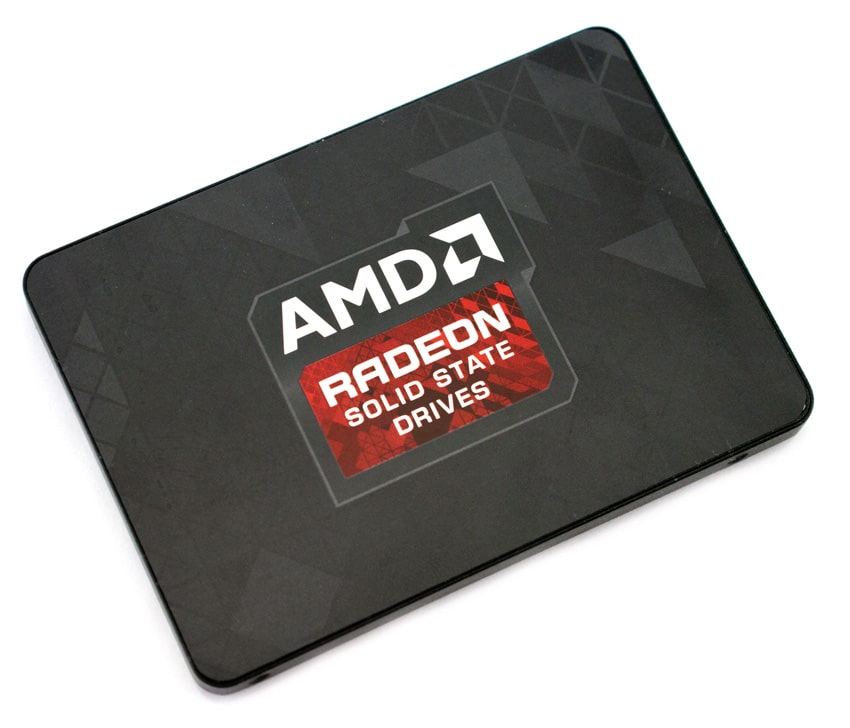
Like other recent OCZ solid state drives like the Vector 150 Series and Vertex 460 Series, the Radeon R7 SSD is equipped with the Barefoot 3 controller. This, coupled with its Toshiba A19 NAND allows for quoted transfer speeds of up to 550MB/s read and up to 530MB/s write, placing it right between the two OCZ drives performance-wise. OCZ states that it is architected specifically for superior mixed and real-world workloads, and is tuned for the gaming audience to which it’s targeted.
Because many of these SSDs are going into PCs, AMD includes with the Radeon R7 a 3.5” desktop adapter and the Acronis True Image HD cloning software. The upgrade bundle carries a $55 value, which is a nice addition that has lately been scrapped from the mainstream and value-oriented SSDs classes.
The Radeon R7 Series comes in capacities of 120GB, 240GB, and 480GB, which are priced at $99.99, $163.99, and $298.99 respectively. All drives are backed by a 4-year warranty. We will be looking at the 240GB unit for this review.
Radeon R7 Series SSD Specifications
- Capacity:
- 120GB (RAD600-25SAT3-120G)
- 240GB (RAD600-25SAT3-240G)
- 480GB (RAD600-25SAT3-480G)
- Controller: Barefoot 3 M00
- NAND Components: A19nm Toshiba Multi-Level Cell (MLC) Flash
- Interface: SATA 3.0 6Gb/s
- Form Factor: 2.5-inch; ultra-slim 7mm
- Performance:
- Max Read: 550MB/s
- Max Write:
- 470MB/s (120GB)
- 530MB/s (240GB)
- 530MB/s (480GB)
- Max Random Read IOPS (4K QD32):
- 85,000 (120GB)
- 95,000 (240GB)
- 100,000 (480GB)
- Max Random Write IOPS (4K QD32): 90,000
- Steady-State Random Write IOPS (4K QD32):
- 12,000 (120GB)
- 20,000 (240GB)
- 23,000 (480GB)
- Data Path Protection: BCH ECC corrects up to 44 random bits/1KB
- Encryption: 256-bit AES-compliant
- Product Health Monitoring: Self-Monitoring, Analysis and Reporting Technology (SMART)
- Endurance: Rated for 30GB/day of host writes for 4 years under typical client workloads
- MTBF: 2.3 million hours
- Power Consumption
- Idle: 0.6W
- Active: 2.70W
- Operating Temperature: 0°C ~ 70°C
- Shock Resistance: 1500G/0.5ms
- Vibration (Operational): 2.17Grms (7-800Hz)
- Vibration (Non-operational): 16.3Grms (20-2000Hz)
- Warranty: 4-years
Design and build
It’s obvious that AMD focused a lot of its effort on the design of the Radeon R7, as hardcore gamers tend to care a little bit more about the look and feel of their hardware and equipment. The drive is very slick looking, with a black-matte color scheme that includes various embedded patterns around the enclosure. At the front and center of the drive is the AMD/Radeon logo where it simply indicates “Solid State Drives”.
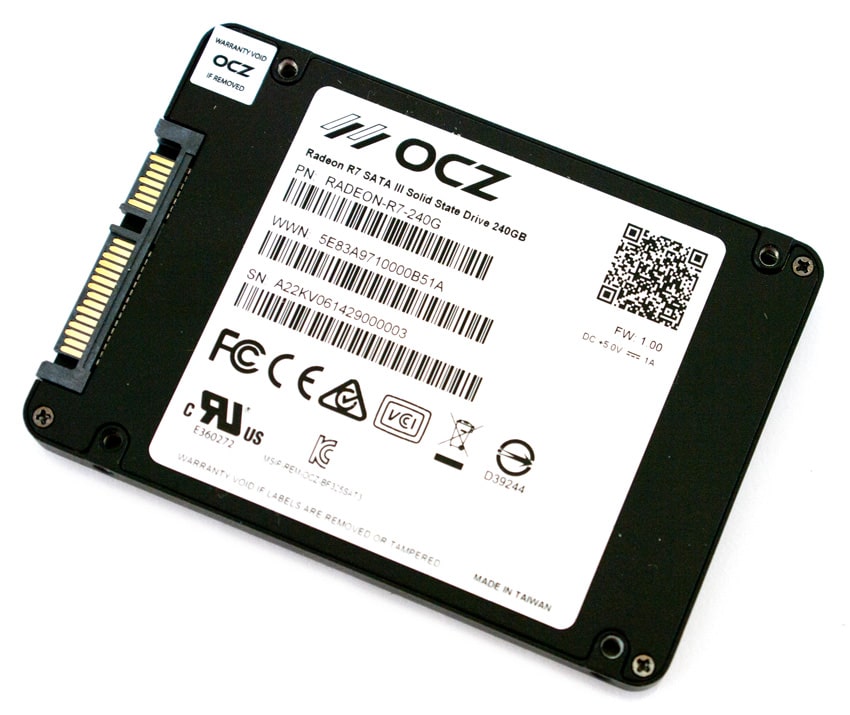
When turning over the drive, the backside displays a standard information label, which provides users with serial numbers, model number, PNs, and other specific information the user may need to know.
Additionally, each side of the Radeon R7 Series has two screw holes for easy mounting.
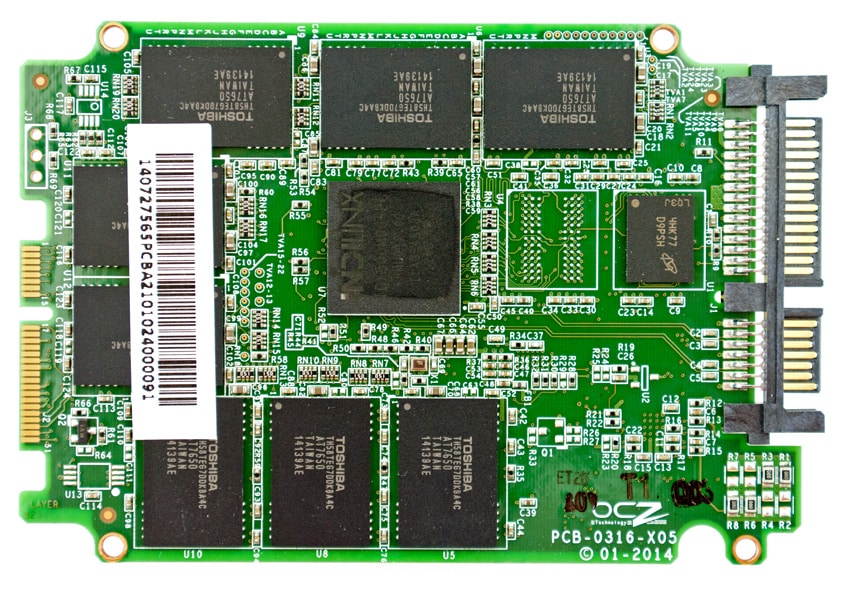
Though it will likely used more often in high-end desktops, its ultra slim 7mm 2.5-inch form-factor allows the Radeon R7 Series to fit in gaming laptops and ultrabooks as well as other embedded solutions. The front of the SSD has a standard SATA power and data interface.
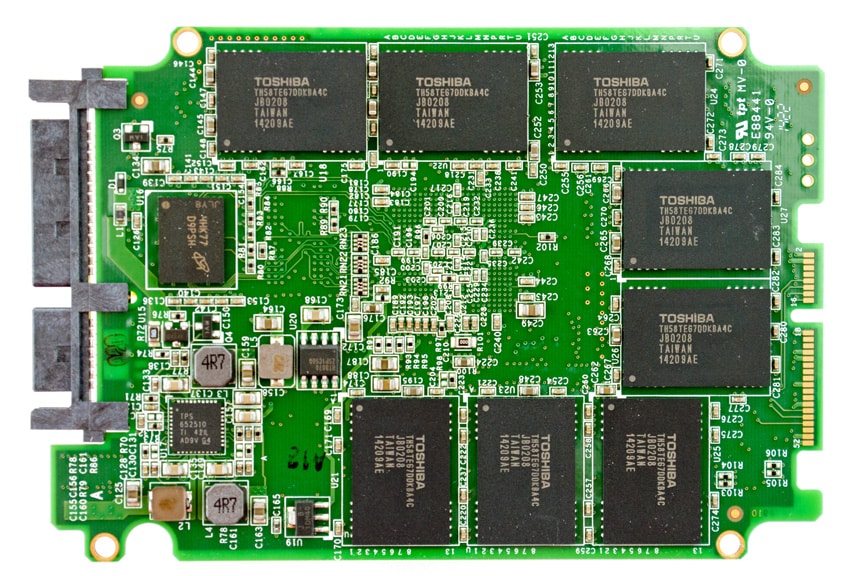
Under the hood lays the OCZ Barefoot 3 M00 controller and Toshiba A19nm MLC NAND.
Consumer Synthetic Benchmarks
All consumer SSD benchmarks are conducted with the StorageReview Consumer Testing Platform. The comparables used for the Radeon R7 Series SSD review include:
- Samsung SSD 850 Pro 1TB (Samsung 32 layer 3D V-NANDND, Samsung MEX S4LN045X01-803 controller, SATA)
- Intel SSD 730 480GB (Intel 20nm NAND Flash Memory, PC29AS21CA0 controller, SATA)
- OCZ Vertex 460 240GB (Toshiba 19nm MLC Flash NAND, Barefoot 3 M10 controller SATA)
- Crucial/Micron M550 512GB (20nm 64Gb/128Gb MLC NAND, Marvell 88SS9189, SATA)
- SanDisk Extreme Pro 960GB (SanDisk 1Ynm, eX2 ABL MLC Flash, SATA)
- Crucial MX100 512GB (Micron 20nm MLC NAND, Marvell 88SS9189 controller, SATA)
All IOMeter figures are represented as binary figures for MB/s speeds.
Our first test measures 2MB sequential performance. Here, the Radeon R7 Series SSD posted decent results with 497.9MB/s read and 447.2MB/s write, which ranks in the middle of the pack.
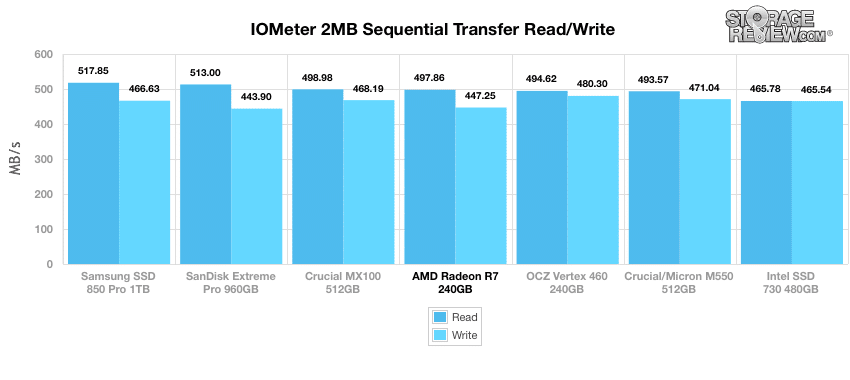
When looking at 2MB random transfer workload, the Radeon R7 Series SSD scored 432.6MB/s read and 445.7MB/s write, ranking toward the back.
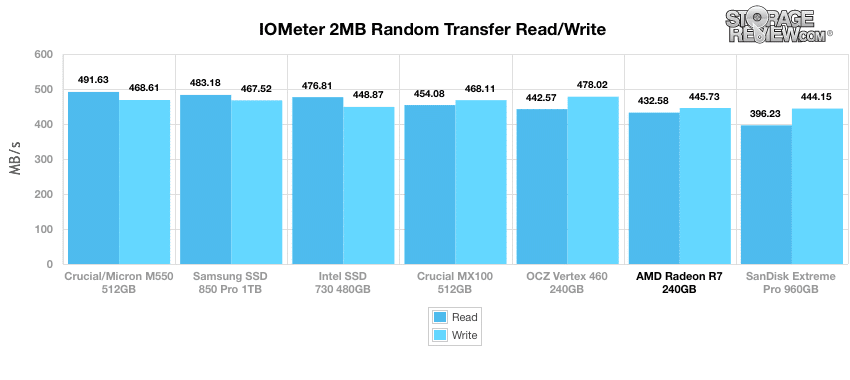
Next, we move on to our smaller 4K random transfers test, where the Radeon R7 Series SSD ranked second last for read (6,943IOPS) but near the top of the leaderboard for write (22,109IOPS). The Samsung Pro took first place for read while the Crucial MX100 took top spot for write with 8,748IOPS and 24,120IOPS respectively.
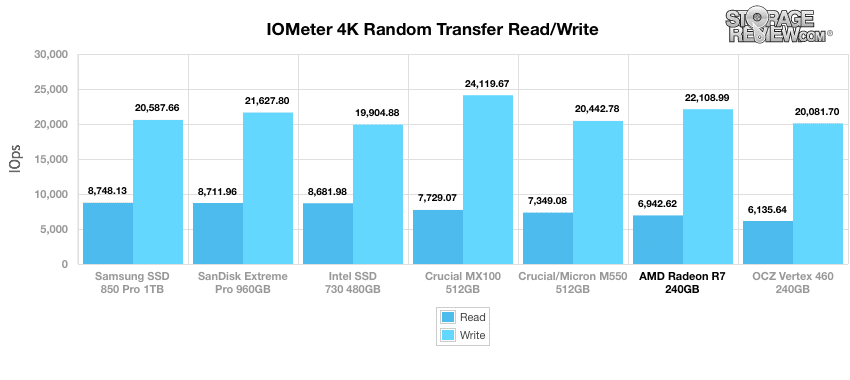
Next, we compare the Radeon R7’s average write latency to each of the consumer-grade SSDs. Here it placed very well among the leaderboard, with an average latency of only 0.045ms (top spot) and peak latency of 3.62ms (4th spot).
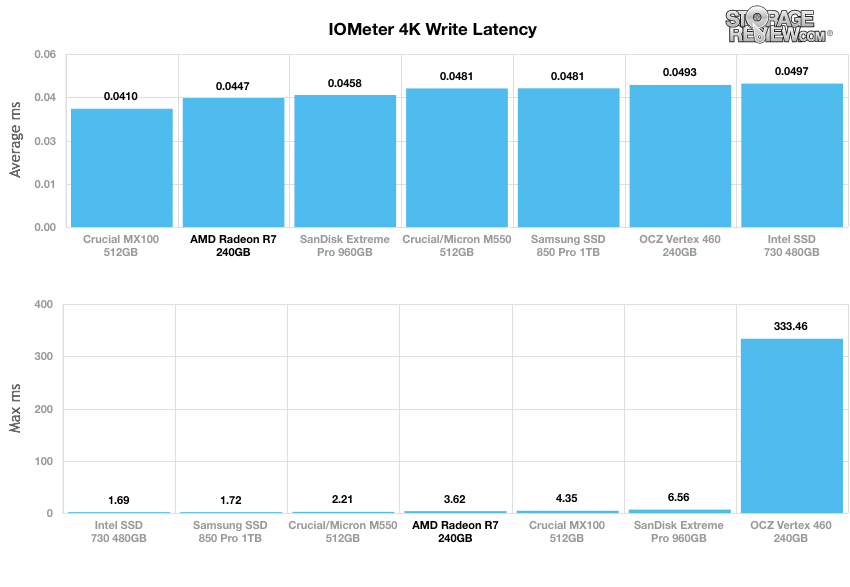
Our next test shifts to a workload with 100% write activity that scales from 1QD to 64QD. In this scenario, the Radeon R7 Series SSD scaled from 22,623IOPS to a sub-par 81,581IOPS, the latter which ranked near the bottom.
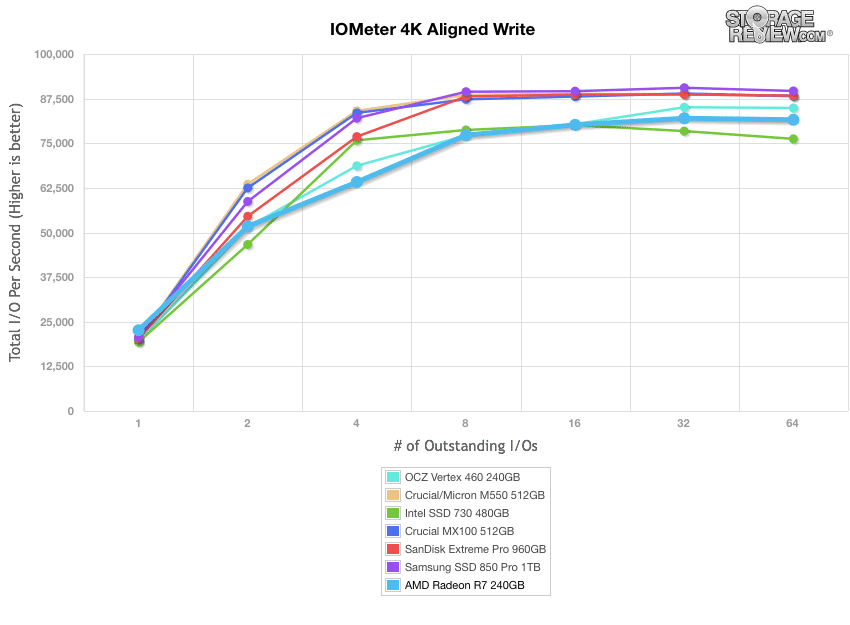
Looking at read activity, the Radeon R7 Series SSD showed a 1QD of 6,933IOPS and up to 91,712IOPS at 64QD, ranking towards the upper middle of the pack. The Samsung SSD 850 Pro was the top performer here (99,386IOPS) by the QD64.
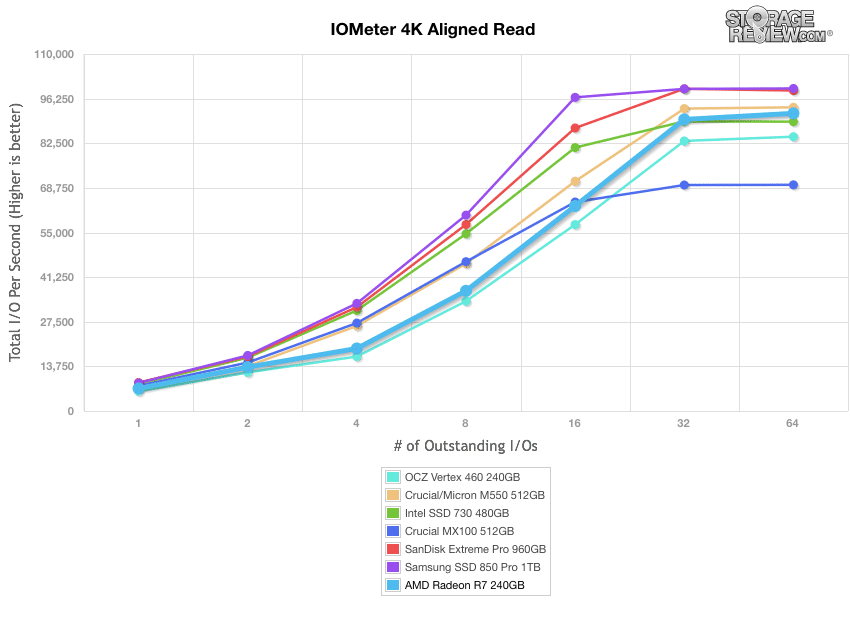
Our last series of synthetic benchmarks compare the drives in a series of server mixed-workloads with a queue depth of ranging from 1 to 128. Each of our server profile tests has a strong preference towards read activity, ranging from 67% read with our database profile to 100% read in our web server profile.
The first is our database profile, which consists of a 67% read and 33% write workload mix primarily centered on 8K transfer sizes. The Radeon R7 Series SSD recorded a QD1 of 6,784IOPS with a QD128 46,835IOPS, ranking in the near the middle of the pack. The top performer by the QD128 here was the Samsung 850 Pro (56,484IOPS).
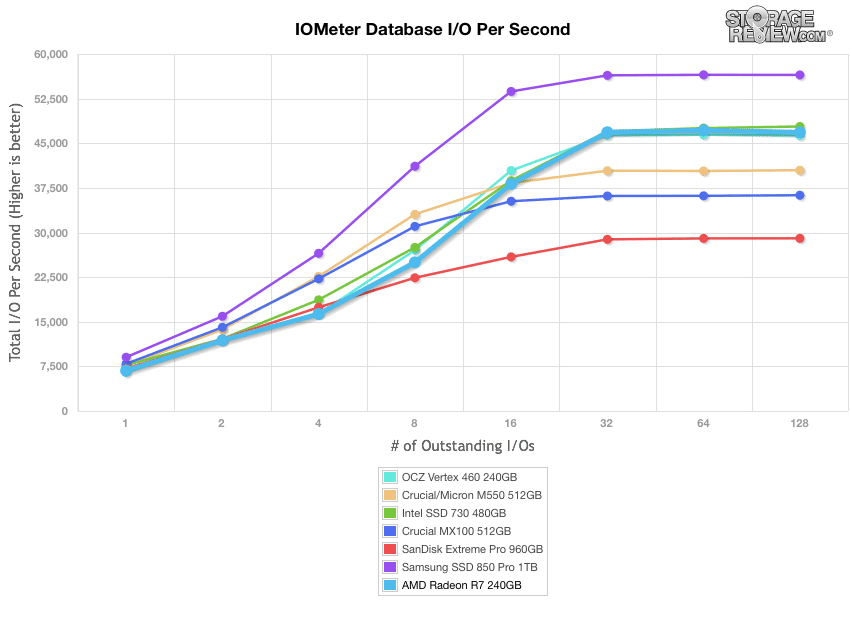
In our a file server, which has a 80% read and 20% write workload spread out over multiple transfer sizes ranging from 512-byte to 64KB, the Radeon R7 Series SSD came in 3rd place by QD128 (30,589IOPS) behind the Samsung and Vertex drives.
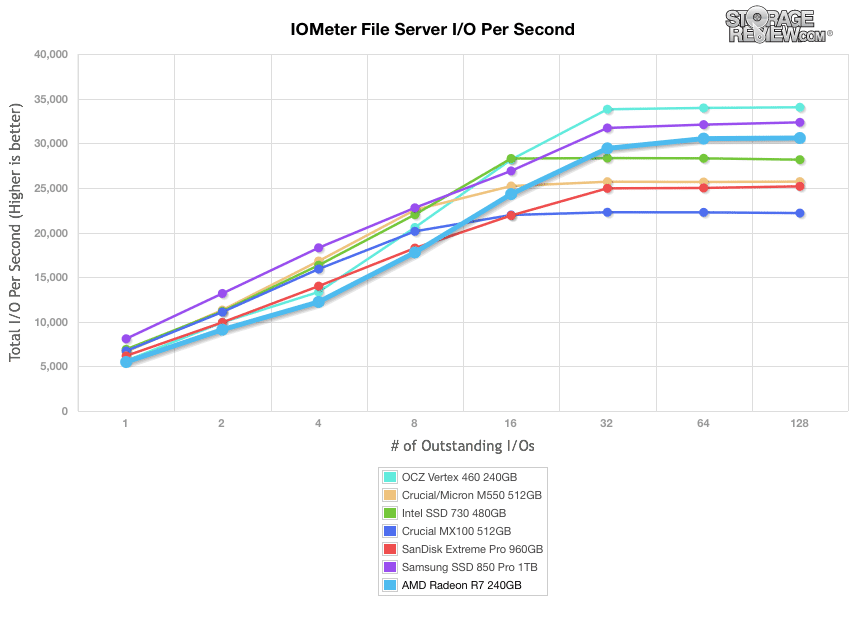
Our web server profile is read-only with a spread of transfer sizes from 512-byte to 512KB. Here, the Radeon R7 Series SSD placed third once again (26,717IOPS) by the QD128.
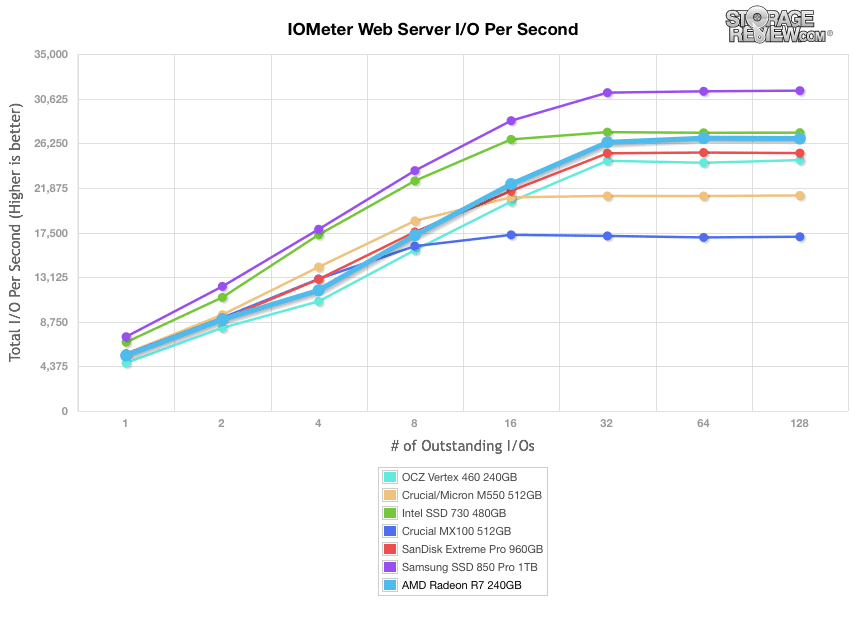
The last profile looks at workstation activity, with a 20% write and 80% read mixture using 8K transfers. In this workload, the Radeon R7 Series SSD continued to fair well, placing at the top of the leaderboard with 49,333IOPS at QD128, narrowly being beaten out by the Intel SSD 730.
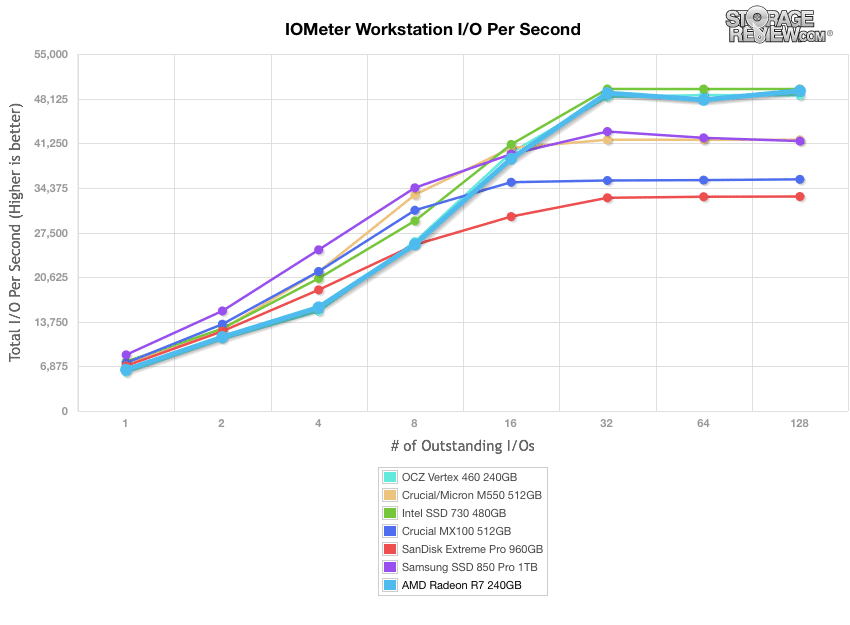
Consumer Real-World Benchmarks
For the average consumer, trying to translate random 4K write speeds into an everyday situation is pretty difficult. It helps when comparing drives in every setting possible, but it doesn’t exactly work out into faster everyday usage or better game loading times. For this reason we turned to our StorageMark 2010 traces, which include HTPC, Productivity, and Gaming traces to help readers find out how a drive might rank under their conditions.
The first real-life test is our HTPC scenario. In this test we include: playing one 720p HD movie in Media Player Classic, one 480p SD movie playing in VLC, three movies downloading simultaneously through iTunes, and one 1080i HDTV stream being recorded through Windows Media Center over a 15 minute period. Higher IOps and MB/s rates with lower latency times are preferred. In this trace we recorded 2,986MB being written to the drive and 1,924MB being read.
In our HTPC profile, the Radeon R7 Series SSD posted results near the bottom of the leaderboard, with an average speed of 239.7MB/s, 5,172IOPS and an average latency of 1.47ms. The top performer here was the SanDisk Extreme Pro SSD.
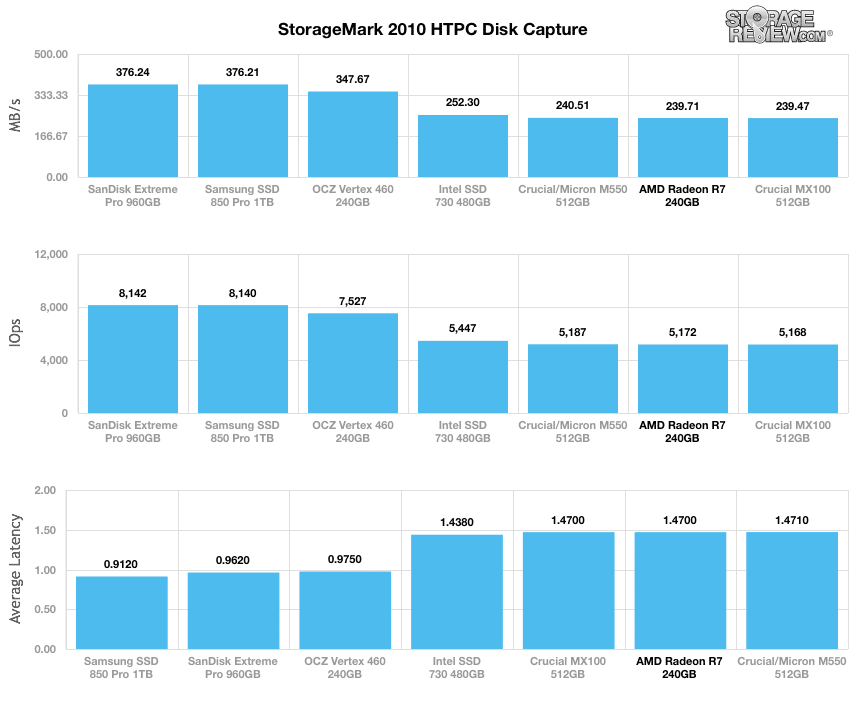
Our second real-life test covers disk activity in a productivity scenario. For all intents and purposes this test shows drive performance under normal daily activity for most users. This test includes: a three hour period operating in an office productivity environment with 32-bit Vista running Outlook 2007 connected to an Exchange server, web browsing using Chrome and IE8, editing files within Office 2007, viewing PDFs in Adobe Reader, and an hour of local music playback with two hours of additional online music via Pandora. In this trace we recorded 4,830MB being written to the drive and 2,758MB being read.
In our Productivity trace, the Radeon R7 Series SSD posted results significantly lower than the leading drive (though ranking in the middle), with an average speed of only 141.4MB/s and IOPS of 4,832.
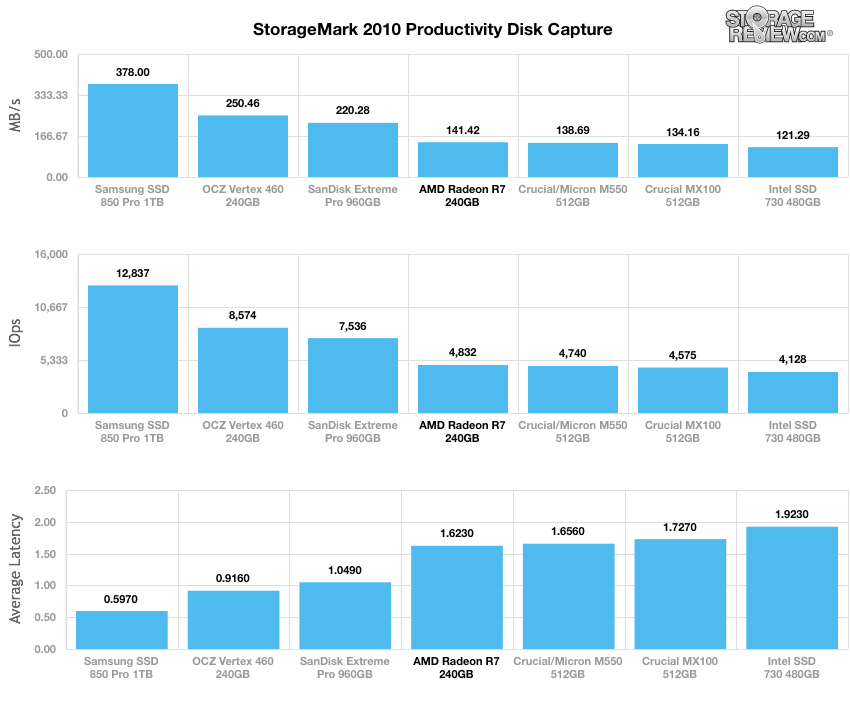
Our third real-life test covers disk activity in a gaming environment. Unlike the HTPC or Productivity trace, this one relies heavily on the read performance of a drive. To give a simple breakdown of read/write percentages, the HTPC test is 64% write, 36% read, the Productivity test is 59% write and 41% read, while the gaming trace is 6% write and 94% read. The test consists of a Windows 7 Ultimate 64-bit system pre-configured with Steam, with Grand Theft Auto 4, Left 4 Dead 2, and Mass Effect 2 already downloaded and installed. The trace captures the heavy read activity of each game loading from the start, as well as textures as the game progresses. In this trace we recorded 426MB being written to the drive and 7,235MB being read.
In our read-intensive Gaming trace, which is what the SSD was designed for, the Radeon R7 luckily picked up its performed, posting an IOPS of 8664.7 and with a speed of 455.6MB/s. Though it ranked last, the discrepancy between the AMD drive and the top performing drive were negligible.
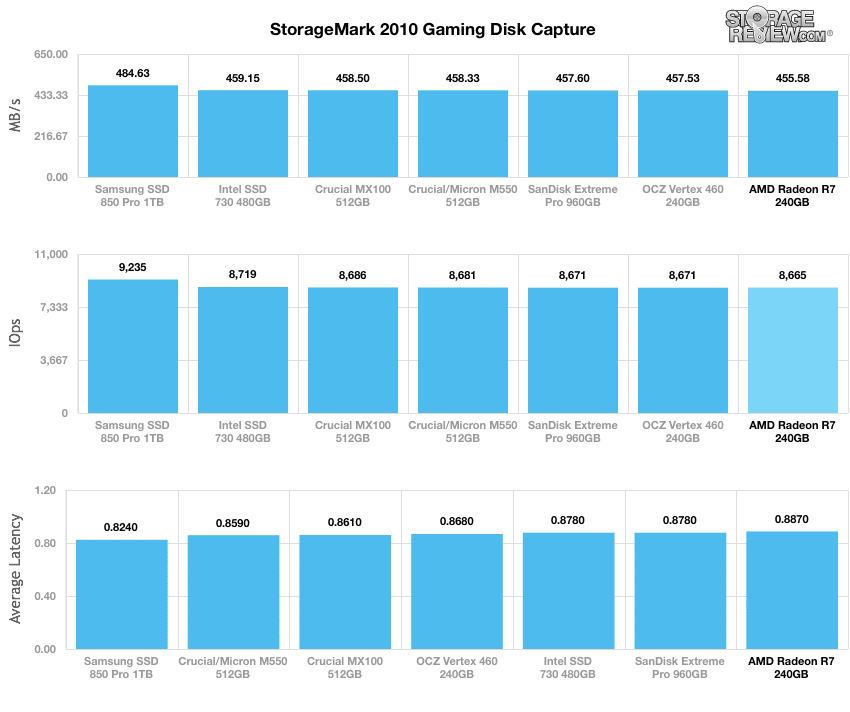
Power Consumption
The Radeon R7 is quoted by AMD as having an idle reading of 0.6W as well as an active consumption of 2.7W.
That said, when we put it through our tests, we measured idle power consumption of exactly what was quoted by AMD with 0.6W as well as a highest measured total at 3.52W, which took place during write activity (2.11W for read).
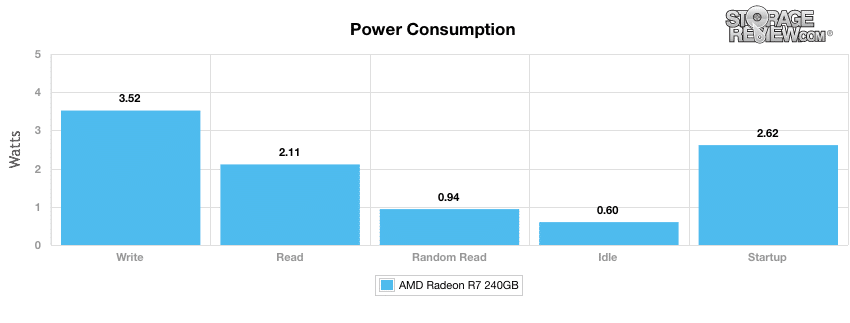
Conclusion
The Radeon R7 Series SSDs are AMD’s latest addition to their line of gaming products. The Radeon R7 Series of SSDs are built by OCZ, pairing throughput with a high endurance rating of 30GB per day for 4 years. The SSDs give AMD another way to connect with a dedicated user-base, though it remains to be seen how loyal they’ll end up being, in a space that’s highly competitive.
When looking into the specifics of its performance, the Radeon R7 Series SSD posted results all over the board. In our 2MB performance benchmarks, it offered sub-par speeds, though it did record a better than average score in our sequential read transfer tests. The smaller 4K transfer tests told a similar story with the exception of our latency readings, in which is offered excellent performance ranking among the top of the leaderboard. The AMD Radeon R7 drive showed its best consistency in performance during our synthetic benchmarks (which looks at a series of server mixed-workloads with a queue depth of ranging from 1 to 128), posting above average results in all of our workloads. Unfortunately, it didn’t outperform any of the comparables in our gaming profile, which is what AMD indicated it was specifically designed for; in fact, it came in last place. Even though it finished at the bottom by only a negligible margin, we expected it to better due to its target demographic, especially for its price. For example, An additional $30 will get you a Samsung 850 Pro SSD, which offers superior performance in almost every category, including our gaming workload benchmark.
The Radeon R7 includes a handy desktop adapter as well as cloning software and it also posts a very high MTBF rating of 2.3 million hours, which his higher than all of the other OCZ drives to date, so there should be a reliability advantage. Ultimately AMD’s new drive doesn’t really do much to distinguish itself from other high-performance SSDs, particularly with a gaming emphasis, and the price tag needs to be lowered just a tad in order to be considered as a serious option.
Pros
- Good endurance, MTBF rating
- Bundled with 3.5” desktop adapter and Acronis True Image HD cloning software
Cons
- Little benefit compared to OCZ’s other offerings
- Gaming profile should have performed better
Bottom Line
The AMD Radeon R7 Series SSD offers some up-side with endurance and a high MTBF rating, but performance and current pricing hold it back in a market that’s full of options.
AMD Radeon R7 Series SSD at AmazonDiscuss This Review




 Amazon
Amazon